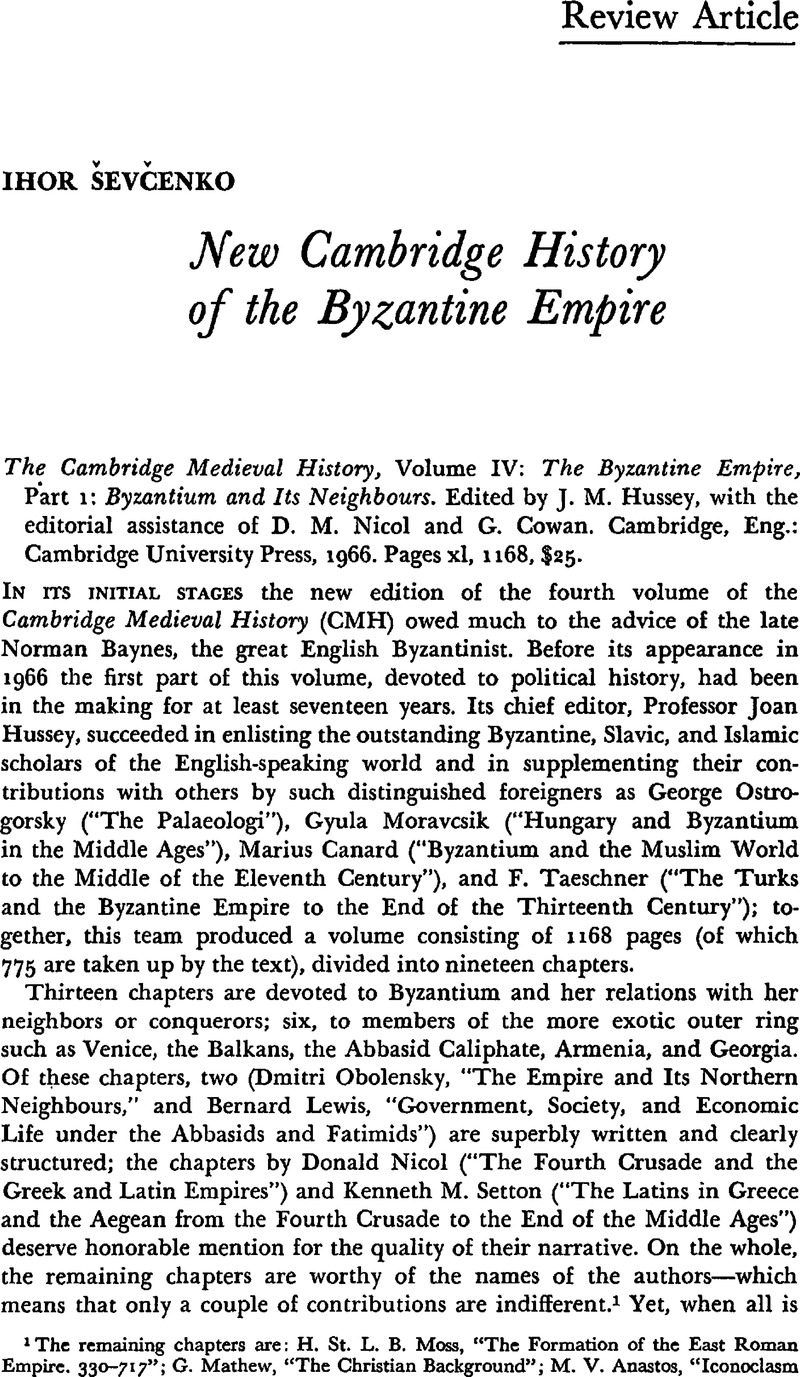No CrossRef data available.
Article contents
New Cambridge History of the Byzantine Empire - The Cambridge Medieval History, Volume IV: The Byzantine Empire, Part 1: Byzantium and Its Neighbours. Edited by J. M. Hussey, with the editorial assistance of D. M. Nicol and G. Cowan. Cambridge, Eng.: Cambridge University Press, 1966. Pages xl, 1168, $25.
Published online by Cambridge University Press: 27 January 2017
Abstract

- Type
- Review Article
- Information
- Copyright
- Copyright © Association for Slavic, East European, and Eurasian Studies. 1968
References
1 The remaining chapters are : H. St. L. B. Moss, “The Formation of the East Roman Empire. 330-717“; G. Mathew, “The Christian Background“; M. V. Anastos, “Iconoclasm and Imperial Rule 717-842“; H. Gregoire (with supplement by R. J. H. Jenkins), “The Amorians and Macedonians 842-1025“; J. M. Hussey, “The Later Macedonians, the Comneni and the Angeli 1025-1204“; R. Cessi, “Venice to the Eve of the Fourth Crusade“; F. Dvornik, “Constantinople and Rome“; M. Dinic, “The Balkans, 1018-1499“; C. Toumanoff, “Armenia and Georgia“; and G. E. von Grunebaum, “Muslim Civilisation in the Abbasid Period.”
2 D. A. Zakythinos, “La grande brèche dans la tradition historique de l'helléinisme du septième au neuvieme siècle,” Kharisterion eis Anastasion K. Orlandon, III (1966), 300
3 In the mid-ninth century, when it was temporarily in Arab hands, Kamacha was betrayed to the Byzantines by, among other “Christians,” an Armenian prelate. See E. Honigmann, Die Ostgrenze des byzantinischen Retches von 363 bis 1071. (1935, reprint 1961), pp. 56-57.
4 L. Bréhier, review of G. Moravcsik's Byzantinoturcica, Vols. I—II (1942-43), in Syria, XXVI (1949), 146-52, esp. p. 151. See the remark on the cosmopolitan character of the Byzantine society and on the contributions which Turkic Asia made to its traditions, ibid., p. 152.
5 George Acropolites, Historia, ed. A. Heisenberg, Georgii Acropolitae Opera, I (1903), 12, 10 : Theodöros … hon Morotkeodoron apekaloun.
6 Sir William Mitchell Ramsay, “The Intermixture of Races in Asia Minor : Some of Its Causes and Effects,” Proceedings of the British Academy, VII (1917), 21.
7 The great J. B. Bury wore blinkers, too, when he declared Byzantium's chief political function to have been that of the bulwark of Europe against Asiatic aggression (pp. xv-xvi). However, in 1923 it was more difficult to escape cultural self-centeredness than in the 1950s.
8 P. Noailles and A. Dain, Les Novelles de Lion Vile Sage (1944), pp. 242-45 (text and French translation).
9 See the sober and honest appraisal by P. Charanis, “Observations on the Demography of the Byzantine Empire,” commented upon by Hans-Georg Beck, in J. M. Hussey, D. Obolensky, and S. Runciman, eds., The Proceedings of the Xlllth International Congress of Byzantine Studies (1967), pp. 445-63. 474-7.
10 B. Laourdas, “Isidorou, arkhiepiskopou Thessalonikēs, homilia peri tēs harpagēs tōn paidōn kai peri tēs mellousēs kriseōs,” Prosfora eis Stilpōna P. Kyriakidēn (Hellēnika, Supplement 4). 1953. PP. 389-98 , esp.P. 398.
11 Speros Vryonis, Jr., “Isidore Glabas and the Turkish Devshirme,” Speculum, XXXI (1956), 433-43. esp. 442.
12 Basilike D. Papoulia, Ursprung und Wesen der “Knabetdese” im Osmanischen Reich (1963; “Südosteuropäische Arbeiten,” 29), esp. pp. 62 ff.
13 I. Beldiceanu-Steinherr, “La conquête d'Adrianople par les Turcs : La pénétration turque en Thrace et la valeur des chroniques ottomanes,” Travaux et Mémoires, I (1965), 439-61 (ca. 1369); Halil Inalcik, “Edirne'nin fethi,” in the commemorative volume Edime (Ankara, 1964), pp. 137-59 (1361, in agreement with Babinger).
14 J. Darrouzes, Epistoliers byzantins du Xe sèhle (1960; “Archives de l'Orient chretien,” 6), pp. 67, n. 2; 69, n. 5; 74, n. 14.
15 Michael Psellos, Chronographia, V, 14 (I [1926], ed. E. Renaud, 94-95).
16 Louis Robert, “Lcs kordakia de Nicée, le combustible de Synnada,” Journal des Savants, July-Dec. 1961, p. 99.
17 Including delays caused by withdrawals of prospective contributors. I was among the guilty, and wish once more to apologize to Professor Hussey for this.




